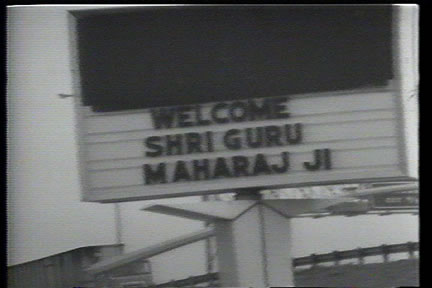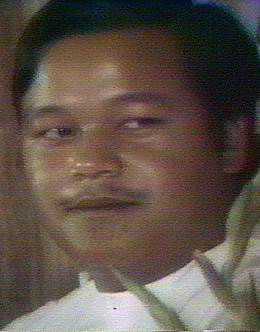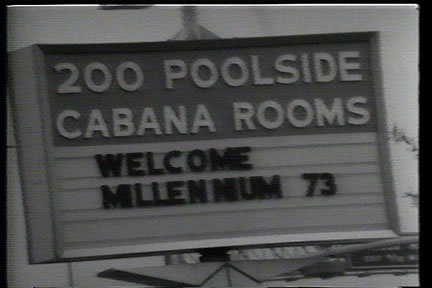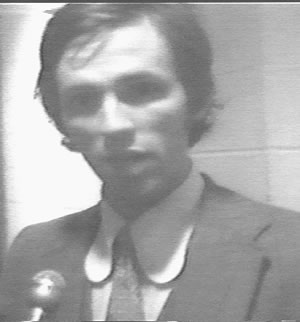Lord of the Universe
Documentary for Television
1974


This brilliant documentary was made during the entire Millennium fiasco back in the fall of 1973. I've excerpted scenes focusing on Maharaji in order to provide a historical perspective for premies and the public who are looking for information on Maharaji. These scenes with Maharaji are only the tip of the iceberg and there are so many more scenes that are on this video that are definitely worth the price of admission. There are clips with Bhole Ji, Mata Ji, Sat Pal and premies. The clips of Bhole Ji are absolutely hysterical, but to see those you will have to buy the video if you can. Lord of the Universe was shown on PBS television in 1974.
Video intro (titles, Rennie Davis, song, Maharaji on stage)
For the sake of Almighty - Maharaji's satsang
Darshan (foot kissing) Montrose, Colorado, 1972
Millennium Press Conference - the Pat Halley story
Houston Airport arrival and satsang
Maharaji's brilliant Superman comic satsang
The Security Guard: "I don't have to think I have Knowledge"
Rennie Davis - Part 2
Rennie Davis - Part 3
Rennie Davis - Part 4
Abbie Hoffman's classic remark - "This is the God the United States deserves"
Hudson Marquez:
Member of the Ant Farm which brought the World the Cadillac Ranch in Amarillo, Texas.
Doug Michaels Tribute
See IMDB,Time Warner Bookmark
Author of The Sopranos Family Cookbook
You may also obtain it from : Video Data Bank, 112 South Michigan Avenue, 3rd Floor/ Receiving n, Chicago, Illinois 606003, USA. Ph: 312-345-3550 (prefix001 from UK), Fx: 312-541-8073. Please go to their website for the most up to date information.
| 16-year-old Guru, Marahaj Ji attempts to levitate the Houston Astrodome in this 1973 DuPont award winning documentary. Follow the guru from his New York mansion to limousines in Houston and listen to his followers celebrities and non-celebrities alike extol his virtues. TVTV's creative use of graphics, live music, and wide-angle-lens shots to conveys the desperate efforts of these lost children to find a leader.
"If this guy is God, then this is the God the United States of America deserves." Abbie Hoffman |
|
Written by Juvenile, June 25, 2004 Reviewer: Disgusted from Los Angeles, CA United States This film is, and always has been, a juvenile attempt to discredit a teacher who has done much for millions around the world. The organizations that support Maharaji's work are not controlled by him and do not provide financial support for him. Nothing about him or his work fits the definition of a "cult". Only juveniles with little or no imagination would find this film interesting. Anyone wanting to know the truth about Maharaji or The Prem Rawat Foundation should see him in person and hear what he has to say or visit www.tprf.org. Anyone interested in the truth about Elan Vital should visit www.elanvital.org. False and libelous statements will never prevent the truth from reaching those who want to know it. |
| Why was he called "Lord of the Universe" in the '70s? In Western culture, when a title is given to a person, it comes with a position. In India, by contrast, such grand labels as "His Holiness" or "Lord of the Universe" are given on the basis of affection or admiration. The use of this title, which was used only in the '70s an era of love for all things Indian does not imply any claims that the person is holy anymore than the use of "His Excellence" means that the person is an embodiment of excellence. "I am a human being, and you are a human being," says Maharaji, "and that is the basis of this relationship." Other people in India have also been called "Lord of the Universe" well before Maharaji, without its ever implying that they claimed to rule the universe or have anything to do with its creation. |
|
Flower Children and the Roots of Elan Vital Last night we watched the documentary "Lord of the Universe." The 60-minute black and white video examined the planning and execution of the 1973 Millenium Festival honoring infamous cult-leader Prem Rawat, aka Guru Maharaji. The reporters use handheld cameras and body packs to record intimate conversations with many types of people; from doubters, like Abbie Hoffman, to aspirants, to premies, to proponents, like Rennie Davis. It was an extraordinarily interesting video, and well worth the time. One scene stands out in my mind. A young Prem Rawat, who still regards himself as a living God and now directs both the current cult Elan Vital and its sham, non-profit offspring "The Prem Rawat Foundation," lands at Houston International Airport. Guru Maharaji gives a short speech to his devotees near the runway, on a platform stage. He wears garlands of flowers during his brief lecture, and, standing up to leave, he heaves the hefty amount of garlands to one of his security officers, who remains onstage, and exits. Moments after "The Lord of the Universe" has departed, the remaining security man breaks apart the garlands, handing bits and pieces to clamoring devotees. The camera zooms in on the pleading, outstretched hands begging for small bits of flower. When lucky devotees receive some manna, the bearers run to the back of the crowd, laughing ecstatically, holding the flower afixed directly below their noses. The fact that, seconds earlier, these flowers were touched by the living body of God, induces the flower-snarfers to be transported into a crazed state of bliss. All this is deftly captured in the documentary. In one short sequence, the screen reveals how two girls, presumably friends, joyously laugh and giggle, nearly falling to the ground, due to their happiness in receiving a flower worn by Maharaji. As the laughing girls buckle, gleefully inebriated with their fortune, a lone, teenaged boy lurking in the background, who also received a god-touched flower, walks closer, holding the flower afixed to his nose. Keeping himself at a safe distance from the girls while clutching his own bounty, he glances and smiles approvingly toward the girls, indicating he shares and understands their mutual, newfound advantage. Meanwhile, throngs of other devotees have not received flowers, and their wails of desperation and misery are overheard on the soundtrack. Among other successes, this documentary successfully juxtaposes the duality of the flower sniffers' religious rapture amid the flowerless followers' wails of suffering. The scene shows how, in the context of a cult, some lucky followers become privileged with a deserved or undeserved honor, while their equals unexplainably do not. The disadvantaged are then ostracized precisely because of their misfortune. Oddly, there was no evidence exemplifying the notion of sharing the god-touched flowers equally amongst the cult members attending this event. Granted, had the devotees offered to share their god-touched flowers with the have-nots, it would still not have appeared as anything less than eccentric cult behavior. All the same, privileged followers in no way shared their bounty with the less fortunate, preferring, instead, to ecstatically commune with their precious flower amongst other advantaged premies, in plain view of the painfully disadvantaged. In a similar vein, the video addresses this duality in the context of receiving Knowledge. The videographers interview ex-premies, who convey that some individuals are selected for initiation, some are not. By weeding out the crowds before and during the Knowledge session, ex-cult members contend that Maharaji's organization artificially increases the aspirants' desire to become initiated. As Mahatmas purposely pluck the rejects from the room, the remaining inductees' need for belonging becomes bolstered, and their intensive belief in Maharaji becomes rigidified. By privileging some and not others, the cult creates its own artificial mystique. While some followers reach levels of ecstasy heretofore unknown, others are cast into an ocean of misery and despair. Indeed, the documentary depicts how the cult was planting the seeds of its own demise, even in the early years, by invoking the tools of deception, fraud, and unfair advantage, for the sole aim of self-propagation. This documentary exemplifies excellent journalistic skills while exposing the high crimes of an unholy family. |





 Home
Home